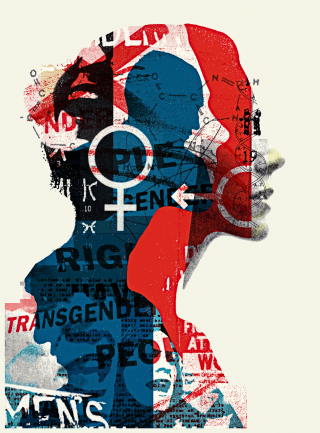An excerpt from this article in The New Yorker: http://www.newyorker.com/magazine/2014/08/04/woman-2

As transgender rights gain acceptance, radical-feminist views have been shunned.
CREDIT ILLUSTRATION BY ALEX WILLIAMSON.
On May 24th, a few dozen people gathered in a conference room at the Central Library, a century-old Georgian Revival building in downtown Portland, Oregon, for an event called Radfems Respond. The conference had been convened by a group that wanted to defend two positions that have made radical feminism anathema to much of the left. First, the organizers hoped to refute charges that the desire to ban prostitution implies hostility toward prostitutes. Then they were going to try to explain why, at a time when transgender rights are ascendant, radical feminists insist on regarding transgender women as men, who should not be allowed to use women’s facilities, such as public rest rooms, or to participate in events organized exclusively for women.
The dispute began more than forty years ago, at the height of the second-wave feminist movement. In one early skirmish, in 1973, the West Coast Lesbian Conference, in Los Angeles, furiously split over a scheduled performance by the folksinger Beth Elliott, who is what was then called a transsexual. Robin Morgan, the keynote speaker, said:
I will not call a male “she”; thirty-two years of suffering in this androcentric society, and of surviving, have earned me the title “woman”; one walk down the street by a male transvestite, five minutes of his being hassled (which he may enjoy), and then he dares, he dares to think he understands our pain? No, in our mothers’ names and in our own, we must not call him sister.
Such views are shared by few feminists now, but they still have a foothold among some self-described radical feminists, who have found themselves in an acrimonious battle with trans people and their allies. Trans women say that they are women because they feel female—that, as some put it, they have women’s brains in men’s bodies. Radical feminists reject the notion of a “female brain.” They believe that if women think and act differently from men it’s because society forces them to, requiring them to be sexually attractive, nurturing, and deferential. In the words of Lierre Keith, a speaker at Radfems Respond, femininity is “ritualized submission.”
In this view, gender is less an identity than a caste position. Anyone born a man retains male privilege in society; even if he chooses to live as a woman—and accept a correspondingly subordinate social position—the fact that he has a choice means that he can never understand what being a woman is really like. By extension, when trans women demand to be accepted as women they are simply exercising another form of male entitlement. All this enrages trans women and their allies, who point to the discrimination that trans people endure; although radical feminism is far from achieving all its goals, women have won far more formal equality than trans people have. In most states, it’s legal to fire someone for being transgender, and transgender people can’t serve in the military. A recent survey by the National Center for Transgender Equality and the National Gay and Lesbian Task Force found overwhelming levels of anti-trans violence and persecution. Forty-one per cent of respondents said that they had attempted suicide.
Yet, at the same time, the trans-rights movement is growing in power and cachet: a recent Time cover featuring the actress Laverne Cox was headlined “THE TRANSGENDER TIPPING POINT.” The very word “transgender,” which first came into wide use in the nineteen-nineties, encompasses far more people than the term “transsexual” did. It includes not just the small number of people who seek gender-reassignment surgery—according to frequently cited estimates, about one in thirty thousand men and one in a hundred thousand women—but also those who take hormones, or who simply identify with the opposite gender, or, in some cases, with both or with neither. (According to the National Center survey, most trans women have taken female hormones, but only about a quarter of them have had genital surgery.) The elasticity of the term “transgender” has forced a rethinking of what sex and gender mean; at least in progressive circles, what’s determinative isn’t people’s chromosomes or their genitals or the way that they were brought up but how they see themselves.
Having rejected this supposition, radical feminists now find themselves in a position that few would have imagined when the conflict began: shunned as reactionaries on the wrong side of a sexual-rights issue. It is, to them, a baffling political inversion.
Read the rest HERE
